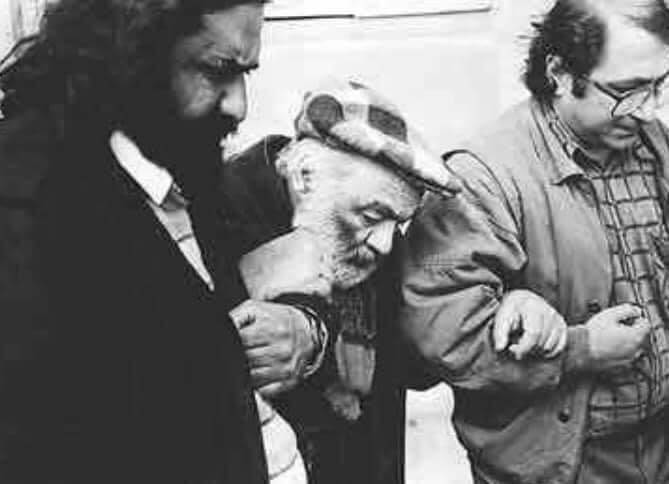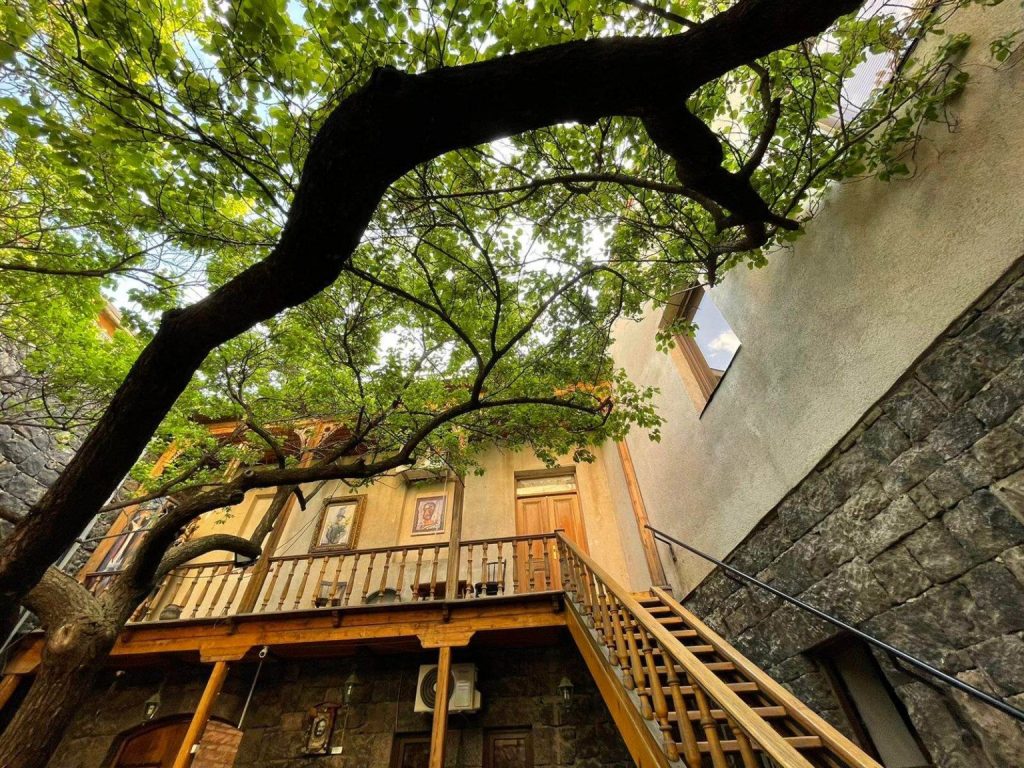Foundation of the Sergei Parajanov Museum

Ghazaryan initially aspired to become a painter like his father, who taught many of the notable Armenian painters of the 20th century, but ultimately fell in love with architecture and earned a degree in the subject from Yerevan State Polytechnic University in 1976.
Throughout his career as an architect, Ghazaryan participated in numerous projects. He was employed by the ARMSTATE Project Institute, which undertook numerous projects. He was appointed head architect of the Dzoragyugh Ethnographic District Project, the first of its kind in the Soviet Union, in 1983. The project was run by the Department of Preservation and Restoration of Historical Monuments. The Sergei Parajanov Museum would eventually be incorporated into the Dzoragyugh Ethnographic District Project.
Collages by Sergei Parajanov were brought to Yerevan in 1988 by photographer and director of the Folk Art Museum Zaven Sargsyan, who later took over as head of the Sergei Parajanov Museum. These collages were made by Parajanov when he was imprisoned and are credited with saving his life. Ghazaryan was among the numerous Armenians and foreign guests who came to see the show.
Ghazaryan and numerous other artists, including Sargsyan and Grigor Khanjyan, thought that Parajanov needed a home-museum. Ghazaryan had the concept for a site in the Dzoragyugh Ethnographic District after seeing the exhibit at the Folk Art Museum.
This notion was communicated by Ghazaryan to Khanjyan, Karen Demerdjian’s informal fine art advisor and the curator of the Dzoragyugh Ethnographic District Project. Khanjyan traveled to Demerdjian and asked him to provide Parajanov the half-completed cliffside structure in Dzoragyugh as a house-museum.
“Demerdjian agreed, and the decision was made. After that, Parajanov’s other artwork was brought from Tbilisi [to Yerevan] overnight. It was a major project. We were rushing for that building to be given to him because Parajanov was already sick.” – ,” said Ghazaryan.

At the time, Parajanov was diabetically sick, his health was deteriorating, and he frequently had trouble walking.
The first time Ghazaryan saw Parajanov was in front of the future house-museum. Ghazaryan felt as if he had met Parajanov long ago when he first watched Shadows of Forgotten Ancestors on television, despite the fact that this was their first encounter in person.
“My impression of him had already been formed 20 years ago when I was a teenager,” recalled Ghazaryan. “For me, he was a spring of pride, an Armenian and a great artist. The most important element was that even though he had done so much work and had so much knowledge, he had no arrogance whatsoever.”
They took a tour of the building together as Ghazaryan described his plans for the building, which included for a place for a living area, a museum, and an art studio.
“I was anxiously waiting to hear what he had to say. I asked, ‘What would you advise us to do better?’ He said, ‘Continue like this. Whatever you have done is good.’”
In 1988 saw the start of building as well as the Karabakh movement. After then, everything started to become challenging.
“But in every situation, Karen Demerdjian, Grigor Khanjyan and city hall were doing everything so that construction could continue. It was going very slowly. Then construction stopped, not because of the movement, but because there was a complaint written to Moscow by a nearby tenant.”
There have been complaints that the building is out of code and upsetting the neighborhood. Construction was put off until the middle of 1989 while Ghazaryan and his team tried to win back approval and demonstrate that they were in fact abiding by all applicable standards.
“We were rushing. We all understood that we had to be quick so that he could live there at least one day for it to become a house-museum.”

Because Parajanov had been diagnosed with lung cancer in 1989 and his health was deteriorating quickly, everyone working on the project was pressed for time. That same year in Moscow, he underwent a pneumonectomy, or lung removal surgery, but regrettably, his health did not get better. Despite this, he continued to be active, even making a trip to Germany in 1990 to accept an award and share the news about the opening of his house-museum and studio.
He arrived to Yerevan on July 17, 1990, and was sent to the hospital after becoming seriously ill.
“The last time I saw him was in the hospital. In three days, he died…on July 20,” shared Ghazaryan.
Parajanov was a well-liked director, artist, and advocate for creative freedom. His work has even influenced American pop culture and continues to inspire people today. He was never allowed to live in the museum and never got to see it come to fruition. The museum is not regarded as a house-museum as a result. A year after his passing, in the summer of 1991, the museum was formally opened.
“Parajanov would go in and out of the museum during its construction,” said Ghazaryan. “His energy remained in the museum. That is why the museum lives on today.”
Ghazaryan said, “We didn’t speak. We just looked at each other. Before he died, he kept saying over and over again ‘I will live in Dzoragyugh.’ I told him very quietly, ‘Dzoragyugh is waiting for you.’”

Leave a Reply
You must be logged in to post a comment.